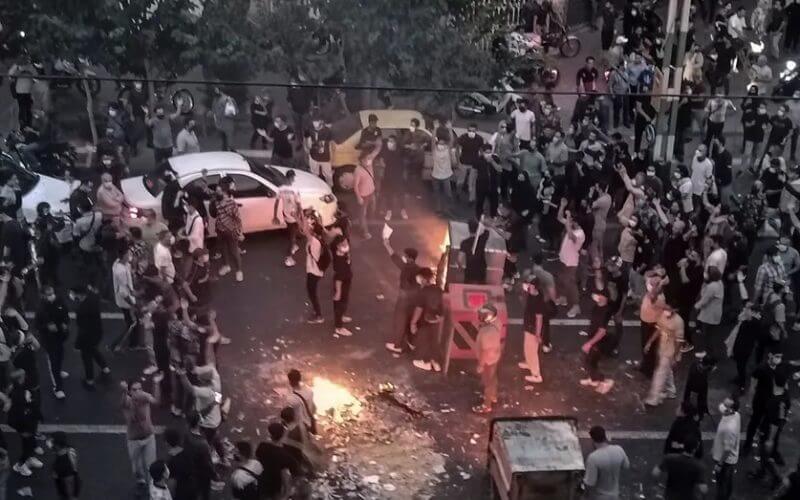LONG READ
Nick Hilden
Thu, November 17, 2022

A Girl's-Eye View of What's Happening in Iran
Iran never seemed to get much consideration from Americans of my generation. It was more of a Boomer thing. Our parents watched the events of the 1970s and 1980s—the Revolution, the hostage crisis, the spiral into repressive theocracy—and so for them, Iran has loomed as a very real, potentially hostile presence. But for millennials who missed all of that, Iran was old news; instead, the Taliban and ISIS were our generational Islamabaddies. Iran’s Supreme Leader would pop up in the news now and again—arrested journalists here, yellow cake there, the will-they-won’t-they of the nuclear deal—but we didn’t pay much attention to anything that resembled a war MacGuffin, having seen the fallout from the Great Aluminum Tube Scare of 2002. We had a bad case of Middle East burnout, in other words.
But if you’ve seen the news, you know that there’s something happening in Iran. What it is isn’t exactly clear—not yet, at least. But it very well could become one of the great advancements in human rights of our time. The world should pay attention—perhaps particularly Americans, who presently find themselves faced with wide-ranging attempts to wrest away hard-won liberties at the hands of a religious zealotry. It’s important to understand what happens when your country falls into the grip of a theocracy.
This story begins and ends with a young woman’s hair, but that’s not what it’s about. Presently, women’s hair, normally an aesthetic concern, is symbolic of something much more. Something revolutionary.
In September, my soon-to-be-niece, Azadeh, flew from Tehran to Istanbul, where she joined my partner Najwa and I to spend her two-week vacation from school. We met her at the airport, and during the taxi ride home, she alternated between excited chatter and shy silence. Though she is close to my partner, it was my first time meeting her, or indeed anyone from Najwa’s family. (Names have been changed out of consideration for safety.)
It was Azadeh’s first trip of this kind: her first solo flight, her first time traveling without her mother and grandmother—my fiancée’s ardently religious maman (my eventual maman-in-law)—and one of the few times in her life when she could go out into the streets without wearing hijab.
I asked what she would like to do while in Istanbul. She smiled somewhat uncertainly and spoke to Najwa in rapid Farsi, which was her tendency until she got to know me better, even though her English is quite good. All I caught was the word Starbucks.
Najwa laughed. “She wants to go to Starbucks.”
Azadeh bristled a bit at the laugh, thinking that maybe she was being teased, then said in English, “It is probably normal for you, but we do not have it in Iran.”
As it turned out, she had a list of brands she wanted to try (she would later declare that Burger King is better than McDonald's, though she thought both were pretty terrible), and while I usually avoid such places, I assured her that we would go. It made sense that a teenager would want to experience pop icons of their ilk, and besides: we always want what we can’t have. Iranians—particularly Iranian women—are barred from a great many things. Western junk chains are the least of them.
At our apartment, Azadeh showered the flight off, then we went out to eat kebab. We were staying in a more traditional district of Istanbul where many women choose to wear hijab, but as we walked through the city’s late summer heat, Azadeh ran her fingers through her long black hair and giggled.
“I’ve never felt my hair dry in the sun before,” she said. “It’s always covered.”
The date was September 10th, 2022. Less than a week later, a 22-year-old Kurdish woman named Jina Amini—more widely known as Mahsa Amini—would die in a Tehran hospital after being arrested by the morality police of the Iranian government for the alleged crime of “improper hijab.” According to witnesses, she was severely beaten while in custody. Iran—and perhaps the world—was about to change.
Najwa and I had flown into Istanbul about a week earlier from the Netherlands, where we attended a conference for Iranian academics and activists in The Hague. There we met a veritable who’s who of Iranian intellectuals-in-exile, including Najwa’s mentor, a Los Angeles-based university professor whom she’d never met in person. When you’re part of a diaspora, digital relationships and networks are powerful tools for maintaining a community scattered across disparate corners of the globe.
I attended the first day of the conference, which was held in English and featured lectures and panel discussions on a variety of topics. More than anything, it struck me as an opportunity for diasporic intellectuals critical of the Islamic Republic—the title given to Iran by its current theocratic regime, a notoriously repressive circumstance that has persisted for more than 40 years—to gather in the real world over coffee and, in the evening, something stronger.
That morning before things kicked off, I stood off to the edge and watched as these provocative Persians became reacquainted, for most of them seemed to know each other. Many went way back, having worked in some degree of concordance ever since leaving their home country in the years and decades following the 1979 Iranian Revolution. Most could not return without fearing prison or worse, because they advocated opinions not shared by the Islamic Republic, and because they outright opposed it. Some appeared to be in their thirties and looked like activists, but many were older and looked like university professors. Many, if not most, are.
After watching a Q&A between Najwa’s mentor Dr. Nayereh Tohidi and a professor named Asef Bayat, who spoke about his concept of non-movement (an idea that encapsulates the ways ordinary people can drive revolutionary change through their everyday actions), I sat in on a talk entitled “Scholars and Artists at Risk,” where lawyer Andra Matei spoke on the need for an international framework for the legal defense of artistic freedom of expression.
Matei—who had the assiduous attitude of a person busied and burdened by a great many responsibilities—operates an organization called Avant-Garde Lawyers that provides legal counsel to artists under attack all over the world. She would later tell me about a case she’s working on that involves a poet the Egyptian government has imprisoned for crimes associated with a song and book of poetry he’d written. According to the freedom of expression advocate organization PEN, these crimes include “blasphemy,” “insulting the military,” and “contempt of religion.” The director of the song’s music video had already died in prison; now, the poet’s release was uncertain.
We discussed the case more before our talk turned to attacks on the freedom of expression in general. It is, we agreed, a global issue. Just two weeks earlier, author Salman Rushdie had been brutally stabbed in western New York more than three decades after Ayatollah Khomeini, the predecessor to Iran’s current Supreme Leader, issued a fatwa accusing the writer of blasphemy and calling for his death. Later that very day, the Turkish singer Gülşen would be arrested for making a joke about the country’s religious schools during a performance.
“Americans like to imagine that it’s only a problem in far-off places like the Middle East,” I noted, “but all across the United States, religious conservatives are banning books that contain anything they don’t agree with. It’s not a long stretch of the mind to see how that could someday evolve into arrests for blasphemy.”
“And at the same time,” Matei exclaimed, “you have liberal college students who demand safe spaces where they don’t have to hear anything they don’t agree with.” Blasphemy of another form.
If blasphemy is a matter of perspective, who gets to define and dole out punishments for it? Humanity is not homogenous. We have nonuniform notions, and history has repeatedly proven that the expectation of adherence to a single conception is destined to be met with dissonance. To deem such difference and dissension intolerable—illegal, even—has well-known, tragic outcomes, from Auschwitz to the Killing Fields, COINTELPRO to the Revolutionary Guard, and so on.
I told Matei that I would poke around and try to find a home for this story. That the Egyptian government is vanishing songwriters into prison struck me as deserving more coverage than it’s gotten.
Dinner that evening was a chaotic affair where beer and wine were poured steadily between various toasts and speeches. There were about eighty of us crammed into a restaurant, and Persian was the dominant tongue.
Seated across from me was activist and writer Mansoureh Shojaee, who went into exile after her efforts to advance women’s rights, including the Iranian Women’s Movement Museum, landed her in the country’s infamous Evin Prison in 2009. A frenetic woman of 64, Shojaee constantly seemed to be holding six conversations at once with the other members of the diaspora seated at our table. These included Nayereh Tohidi and her husband Kazem Alamdari; Dutch Senator Farah Karimi, who had fled Iran in the early 1980s; University of Sussex scholar Kamran Matin; and Bayat, among many others. It was a table at which you could practically taste the smart-stew simmering, even through the scourge of jetlag. Said jetlag was subdued (or perhaps accentuated) by an unfaltering flow of booze and tea.
The next morning, I took my hangover to check out the Peace Palace and the International Court of Justice. While there, I tried to take a photo of the World Peace Flame, but it was very small and difficult to capture. Barely a flicker.

The World Peace Flame, barely flickering in The Hague.
A few weeks later, I was in Istanbul, and Azadeh walked into the room where I was working with a troubled, almost frightened expression on her face. I gave her only a fraction of my attention, focused as I was on trying to wrangle a publisher for the Egypt story. There was frustratingly little interest.
In any case, I diverted a sliver of my bandwidth to my niece-to-be and asked if something was wrong.
“A girl has been killed,” she informed me, her voice solemn. “In Tehran. By the Morality Police. They arrested her and beat her for not wearing hijab properly. And she died.”
In retrospect, my response was poor. Dismissive, almost. I believe I shook my head and said it was sad, but that was all. I was busy and perhaps resented the distraction a little. To me, it sounded like more bad news from a place where bad news, particularly bad news for women, came as no surprise. Azadeh knew better, however—she seemed to intuit that something new was happening or was about to happen, and she persisted.
“Her name was Mahsa Amini,” she continued. “She was not even from Tehran. She was from the Kurdistan of Iran. She was just visiting with her brother, but they killed her anyway.”
She pursed her lips and shrugged her tiny teenage frame as if to say, That is that. That is the way things are. But I could see that she was deeply troubled by what had happened to this woman. I, however, changed the subject and asked if she would like to go to the iconic Galata neighborhood at some point and take some photos, for she is an aspiring photographer. She agreed and I turned back to the screen.
It only took a few hours following Mahsa Amini’s death for protests to spark in Tehran before exploding across the country over the next few days. What appeared to begin as a few scattered, angry gatherings soon erupted into street battles against riot police and elements of the Revolutionary Guard. At first, the primary weapons seemed to be rocks versus batons, but it wasn’t long before Molotov cocktails and gunfire were popping up in videos emerging from all over the country.
Now I was paying attention. In Istanbul, we were watching events unfold minute by minute. Not via the news—traditional media outlets were late by days and even weeks—but by following relevant hashtags like #MahsaAmini, #IranProtests2022, and #IranRevolution2022. Social media was increasingly entering the fray, which is important considering how much the Islamic Republic’s strategy leverages propaganda and misinformation. Even Anonymous claimed to have joined the fight, with the hacker collective and affiliated groups saying they had disrupted Iranian government systems, cameras, and the website of the central bank.

A picture obtained by AFP outside Iran on September 21, 2022, shows Iranian demonstrators taking to the streets of Tehran during a protest for Mahsa Amini, days after she died in police custody. - - Getty Images
As the days passed, it became apparent that this was different from previous protests—these appeared angrier, more widespread, and more sustained. Azadeh, Najwa, and I watched videos leaking out of the country via social media late into the night, stunned by what seemed to be something heretofore unseen. Videos of women dancing and burning their hijabs in the street. Of crowds of protesters hurling barrages of rocks at police. Of crowds chanting death to the dictator and tearing down images of the Supreme Leader. Videos of the police and militias beating women with batons. Of police carefully taking aim and methodically shooting at protesters. Of a young girl apparently shot, her limp body in the arms of a desperate fleeing man. Of a mother wailing over her child’s body. Of blindfolded prisoners herded into jails en masse.
And then the government started shutting down huge swathes of the internet. This is a common tactic among authoritarians attempting not only to disrupt protests, but also hide what’s going on from the world.
News from Iran slowed to a trickle. Many on the outside agonized over its absence.
We decided to keep our niece with us for another couple of weeks to see how things would shake out. One day while Najwa was working, Azadeh and I rode the bus across the city to the bustling tourist district of Galata, where we planned to visit an art gallery and photograph the neighborhood.
On the bus, Azadeh showed me videos posted to social media by pop stars declaring their support for the people of Iran. She asked me if I thought it would help, and I told her I didn’t know—that it couldn’t hurt. That it meant the world was paying attention.
Our conversation turned, as it so often had over the preceding days, to our most optimistic of topics: what things would be like after the regime fell (the ultimate goal of the protests). No more compulsory hijab! Political prisoners freed! Dance clubs! And—eventually—the normalization of relations between Iran and the rest of the world. Greater passport strength for the Iranians, meaning more freedom of movement and expanded access to opportunities. Perhaps it would become easier for Azadeh to study abroad, a proposition that currently lands somewhere between difficult and impossible.
Then there was how it could impact the Middle East in general. The Islamic Republic fuels much of the region’s conflict, from drawing the ire and involvement of the United States, to consistently ratcheting up hostility with neighbors like Saudi Arabia and Israel, to fueling terrorist organizations scattered across several countries. A new secular democratic government could dramatically ease tension across the board. The people’s ousting of a hardline Islamist government could also inspire similar efforts in nations like Iraq and Afghanistan. On a wider scope, a less isolated and antagonistic government could ease some of the proxy brinkmanship between the US and Russia.
It’s a big deal, in other words, with potentially transformative implications.
“It’s so sad that Mahsa Amini had to die before people got angry enough to do something,” Azadeh mused, more thoughtful than gloomy. She paused and considered. “Maybe the only way change happens is if somebody dies.”
Everyone near us on the crowded bus looked at her. Our apartment was in a part of the city where English speakers are few, but they all understood that.

Young women in Istanbul, hair uncovered.
At the art gallery, everything reminded her of Iran. A series of plaster casts of women’s heads hanging by their hair, mouths bloodied. Ceramic figurines of elaborately dressed women, their guts hanging out. A display of women’s portraits, the ink dripping and obscuring their features. After that we made our way down the steep alleys that snake beneath Galata Tower, and as we went along, Azadeh snapped photos of strange-looking doors, random people, and cats.
Eventually we were tired from all the heat and from walking up and down the hill, so we stopped to cool off at… Starbucks, of course. Yes, Turkey is famed for its coffee, but sometimes being an uncle requires sacrifice.
The place was packed with college students, which inspired us to discuss something other than the events in Iran—a welcome break from what was becoming an increasingly fraught subject. Azadeh would be graduating soon and was considering where she would like to attend university. Istanbul topped the list for a number of reasons, not the least of which involved the fact that it wasn’t in Iran, was relatively welcoming to Iranians, and Azadeh already had a working grasp of the language. Above all, it would offer educational and artistic opportunities and freedoms that simply aren’t an option for students in Iran.
She wanted to study graphic design, but worried that her education in Iran had not properly prepared her for a university-level program. With a scornful expression, she explained that they spent too much time studying what she called “Islamic Republic bullshit.”
“Look at that girl,” she said. I’d noticed that she had been watching one of the university students, a young woman with long brown hair who was sitting alone before her laptop and typing intently. She looked to me like a typical college kid that you would encounter anywhere in the world. Azadeh sighed. “She’s so cool. What I want is to be like her, just working on my computer at Starbucks.”
I got the sense—not for the first time and not the last—that Azadeh and the Iranians are suspended in time, waiting for its gears to re-engage and start turning so they can once again move forward. It is a country and a people imprisoned—both metaphorically and in some cases (far too many cases) literally—by an ideology of control. Girls like Azadeh wait for deceptively simple things, like the ability to wear their hair out or enroll in school free of constructed sociopolitical barriers. For those living in exile, time seems to have stopped in 1979. They’ve spent decades in anticipation, fixated on the question of their country, waiting for the day when change will come and they are free to consider new quandaries. Waiting for the day when they can return home without fear of reprisal, without fearing for their very lives or those of their families. Waiting to move on.
A few days later, I interviewed the Turkish novelist and Nobel laureate Orhan Pamuk for The Washington Post. Political repression was at the core of our conversation.
“There is no free speech in Turkey,” Pamuk told me.
In Turkey, Recep Tayyip Erdoğan has ruled as president for nearly a decade, pushing an increasingly authoritarian agenda and courting the Islamists. In the wake of a coup attempt in 2016, the Turkish government arrested thousands of dissidents, including judges and prosecutors, and shuttered scores of media organizations. Shortly after my arrival in Istanbul, there was a large anti-LGBTQ demonstration—this came just months after a violent police assault on the local Pride march. Artists have been imprisoned (like the aforementioned Gülşen, who, reports say, spent five days in jail, fifteen under house arrest, and in October made her first appearance in court while facing a sentence of up to three years—all for joking that her bandmate became a pervert after attending a religious school). Dozens of journalists and writers have been imprisoned too. Now Pamuk has drawn the government’s ire and is currently the subject of an open investigation for insulting the flag and the country’s founder—”crimes” punishable with up to three years in prison.
I asked Pamuk if he would go into prison or flee into exile. He was flippant, saying the question was too hypothetical, but I was not so sure. I’d been spending a lot of time around Iranians for whom prison or exile was an all too real consideration, and Turkey was looking more and more like Iran. This was a concern that Azadeh had raised.
“My niece is Iranian and wants to go to school in Turkey,” I mentioned, “but she’s worried that Erdoğan is turning Turkey into Iran.”
“It’s not true,” he said. “Turkish bureaucracy for many years resisted Erdoğan and now forty percent is secular. Even some people who voted for Erdoğan are secular. Now Turkey is suffering from immense, immense poverty because of the mismanagement of Erdoğan. He will lose even Islamist votes or conservative votes in the next election. So it's not the same situation.
“I respect, admire, and back the brave people of Iran, the brave women of Iran who went out in the streets and protested against power,” he said. “If there were free elections in Iran, no one would vote for the present government. So at least we have a ballot to vote, and the government may change. I hope it will change. I believe it will change. In Iran, they don't have that.”
Ten days after speaking with Pamuk about hypothetical imprisonment, I was confronted by the real deal.
We’d flown back to The Hague, Najwa and I, for an event called “From Evin with Love”—the opening of an exhibition of artwork and handicrafts created by women activists held captive at Iran’s infamous Evin Prison. Launched by Mansoureh Shojaee, who herself had been incarcerated in Evin, the event featured speeches by Senator Farah Karimi (who said that two days before, her niece had been attacked in the street by three men who thought her hijab wasn’t up to snuff), Halleh Ghorashi (another Iranian academic and refugee), and British-Iranian Nazanin Zaghari-Ratcliffe, who was detained in Evin following her 2016 arrest, before being moved to house arrest in 2020, then finally released in March of this year.
There was supposed to be another speaker—Mehraveh Khandan, the daughter of human rights lawyer and activist Nasrin Sotoudeh—but according to Karimi, when she arrived at the airport to fly to the Netherlands, police agents prevented her from leaving the country.
During her speech, Shojaee summed up the situation:
“The citizens of Iran are calling for justice, equality, and freedom, and the world should listen to their chant: Women, Life, Freedom… Women, Life, Freedom is a movement to reveal not only women’s dignity, but human dignity. In this slogan, women represents all of the groups being oppressed in Iran. Life stands for people’s demand for a dignified life, where citizens have access to basic civil rights. Freedom, because Iranians want a democratic society where freedom of expression is a right and nobody can be put in jail for expressing their ideas, gender identity, religion, or political stance. Although these demands may seem natural to you, in the past forty years under the Islamic Republic, thousands of Iranians have been imprisoned or even executed for demanding such rights… We are dedicating this year’s exhibition to Mahsa Amini, whose life was taken by Morality Police violence.”

Protestors in London hold up "Woman, Life, Freedom" signs and Iranian flags.
Woman, Life, Freedom, or in the original Kurdish Jin, Jiyan, Azadi, has become the rallying cry for Iranian protesters. You hear it chanted by both women and men on the front lines of the battle against the forces of the Islamic Republic, and it is the spirit of a movement that has spread to universities, high schools, and even primary schools. As I stood at the back of the room listening to the speeches, watching the crowd of mostly women—many of whom had been waiting for change for decades—I could sense a palpable feeling in the air: hope. There was also, however, an undeniable atmosphere of anticipation that bordered on dread—for who knew what horrors awaited between that moment and the hopeful victory?
After the speeches, we were all separated into groups and blindfolded before being led into the exhibition by volunteers shouting directions. The intention was to provide visitors with a taste of what it’s like to be herded into Evin Prison at the cajoling of the Secret Police—the blindfolds, the uncertainty, the shouted commands.
Finally, we removed our blindfolds to reveal an array of handicrafts by the women prisoners of Evin, each of which had been carefully smuggled out of Iran. These included dolls, scarves, leatherworks, bags, paintings, poems, and other pieces of art, a few of which had been produced by Nasrin Sotoudeh (whose daughter had been prevented from attending the exhibition), as well as the renowned activist Narges Mohammadi, whose recent book chronicles the experiences of women held in solitary confinement in Iran.
Knowing where and under what conditions they were made gave these simple items a surfeit of power. Many were colorful—almost playful even, as they were originally crafted as gifts for the imprisoned women’s children. The effect of this incongruity—blithe color emerging from a place of stone and torture—was both uplifting and chilling. The latter sensation was heightened by the soundtrack playing over the exhibit: the distorted wails, we were told, of mothers whose children had been murdered by the Islamic Republic during the protests.
The following evening, by coincidence, there came more alarming news from Iran: Evin Prison was on fire.
Videos showed the building in flames while gunfire could be heard from within. Security forces, including a branch of the Revolutionary Guard, were deployed to the scene and analysts later concluded that they launched stun grenades into the prison. At the time, there was no explanation for the fire, but Iranians widely assumed that it was part of an effort to liquidate the political prisoners held there. Fear and outrage coursed through online networks.
According to The Washington Post, one prisoner later told his family that when he and other political prisoners attempted to smash through the gates of their ward to escape the fire, guards responded with bullets and tear gas. Amnesty International said in a statement that its investigation into the incident “raises serious concerns” that the authorities used the fire and resulting unrest as an excuse to justify a “bloody crackdown” on prisoners. Later, officials would claim that eight were killed and about sixty injured, but many activists say that the actual numbers are higher. According to activists, many prisoners were then transferred to prisons across the country, an intentional tactic used by the Islamic Republic to create distance between the imprisoned and their families.
Shojaee didn’t sleep that night. I know because Najwa (who also barely slept) and I went to her home for dinner the following day, where she fed us the traditional Iranian dish ghormeh sabzi (a stew of lamb, herbs, dried limes, and beans) along with saffron-dusted rice. She’d been up all night, then spent hours walking from her home in the heart of The Hague to the beach, then back again.
All evening, Shojaee spoke fast and nervous, but she was always charming and indulgent, darting around her apartment playing the good host (which is so Persian—tending to guests in the face of disaster). But her mind was obviously someplace else: with her friends and the other prisoners of Evin. We avoided the topic for a while, but after a few drinks, talk of the prison slipped out. She expressed concern about her friend Narges Mohammadi, whose health conditions could have been exacerbated by the smoke. Medical care is notoriously negligent at the prison. But in any case, Shojaee remained defiant.
“It should be written,” she declared, “that in the history of Iran, even in prison, they fought.”

This image obtained from the Iranian news agency IRNA on October 16, 2022, shows a fire truck in front of Evin Prison, after the blaze.- - Getty Images
How the Iranian protests of 2022 are written into history will depend on how they end. In Istanbul, before Najwa and I returned to the Hague for the Evin exhibition, we spent weeks watching the protests in Iran, thinking each day might be the last, that people would tire of being beaten and gassed and shot and arrested and murdered by riot police. But it didn’t happen. The unrest—which was looking more like a revolution every day—went on. Within less than two months, some 15,000 Iranians would be arrested for protesting or otherwise associating with the demonstrations, and an overwhelming majority of the country’s parliament would sign a letter making a case for their execution. On November 13th, the first death sentence was handed down.

A young woman wearing her hair out in Istanbul.
But that was all yet to pass. After a month, the time came to send Azadeh home, violence or no, because she couldn’t miss any more school. But as the protests continue, the schools have ceased to be places of education and have instead become battlegrounds. Girls are speaking up and removing their hijab. A video shared widely in October showed them chanting at and chasing a man, allegedly an official from the Iranian Ministry of Education, throwing water bottles at him as he fled, while some teachers have joined strikes in opposition to the government. Videos have been circulating in private networks appearing to show girls being attacked, beaten, and arrested on school grounds after pro-regime principals reported them to authorities for the “crimes” of refusing hijab and chanting protest slogans.
Before taxiing Azadeh to the airport, we went shopping for a few things for her to bring back to Najwa’s family—mundane but quality products like laptop bags and milk frothers that cannot be obtained in Iran due to sanctions—then stopped for a lunch of kebab.
When we left the restaurant, the day was trying to decide whether it would storm or shine. The sky was cloudy and the wind strong, but the sun was trying to break through. As we walked down the street, I heard Azadeh giggle from behind me, and I turned to find her patting down her frizzy black mane, which was flying unkempt and wild in the wind.
“My hair,” she giggled again, a wide smile on her face. My heart sank knowing that in a few short hours, she would be forced to corral it beneath compulsory hijab once again, and she would be faced with uncertain dangers.

Azadeh photographing Istanbul.
We collected her luggage from our apartment, then went out to meet the taxi. As it carried us to the airport, I didn’t have much to say. I was worried. The news out of Iran was bad. The number of protesters killed was soaring, among them a 16-year-old girl named Nika Shakarami, whose mother accused the authorities of murdering her and extracting forced statements from members of her family saying otherwise. Now she was just another hashtag on Twitter, and when I looked at her photograph, I saw in it the young face of my soon-to-be niece. It made me feel ill.
Najwa and Azadeh, on the other hand, chatted amiably with our taxi driver, who recognized their Farsi and informed them that he used to work as a truck driver in Iran. A beautiful country, he said, and expressed his support for the protests and his distaste for the mullahs. The driver told us that if the regime fell but Erdoğan was reelected, he would move to Iran. It’s a sentiment I’ve heard all over the world. Everyone everywhere has their own “Canada” they say they’ll move to if everything goes to shit. And damned if an awful lot of us aren’t eyeing our Canadas these days.
At the airport, we checked Azadeh into her flight, then walked her to security. Once there, she embraced Najwa and held her for a very long time. She said that she didn’t want to go back. That her month away from Iran was one of the best of her life.
“When will I see you again?” she asked through tears.
Najwa held her and tried to smile. “Soon.”
Eventually they parted. Azadeh and I exchanged a quick hug, and I attempted to say something but most of it ended up stuck in the hollow feeling in my stomach.
Azadeh’s headscarf was in her backpack, but she wouldn’t wear it until she absolutely had to. We watched her raven-colored head as it wove through the line, eventually making it to passport control, where she was held up for longer than necessary—Iranians always receive extra scrutiny. Finally she was through. She turned and waved, then disappeared from view.













